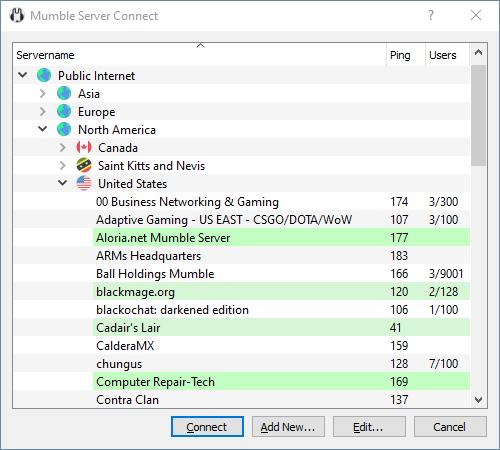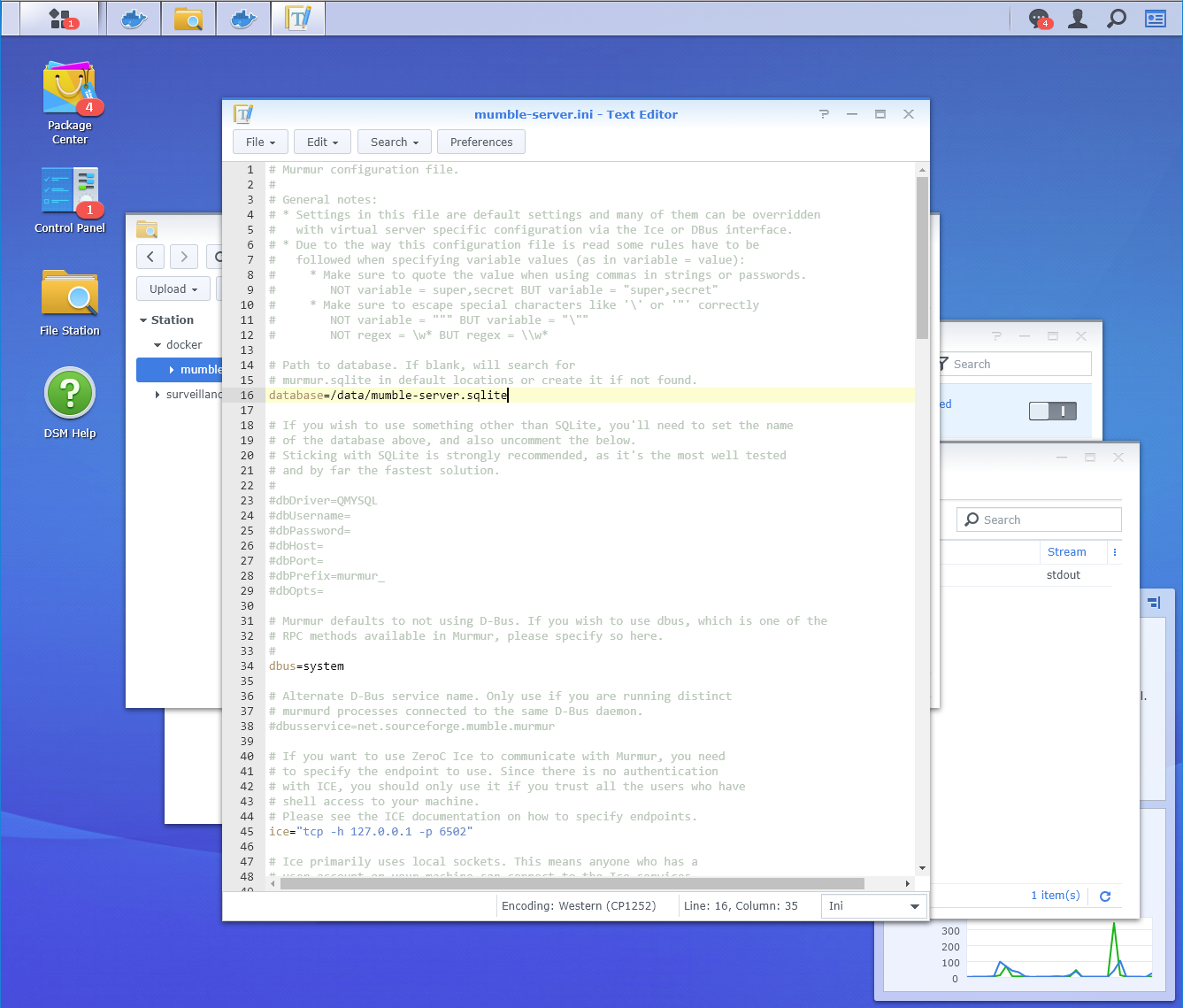From OpenSimulator
Being told that you mumble can be frustrating, especially if you're trying your best to speak up. Since mumbling makes it hard for people to hear you, improving your speech will help you communicate better and share your thoughts. Mumble is a free, open source, low latency, high quality voice chat application. Mumble was the first VoIP application to establish true low latency voice communication over a decade ago. But low latency and gaming are not the only use cases it shines in.
- Mumble is the main protagonist of Happy feet and also, one of the 2 main protagonists of Happy Feet Two Erik being the other. He is a male emperor penguin who is the son of Memphis and Norma Jean, the husband of Gloria, and the father of Erik. He is unique in that he is the only emperor penguin to not have a heart song, and the first to be able to tap dance. Mumble is first seen as an egg.
- Mumble is an open source, low-latency, high quality voice chat software primarily intended for use while gaming This Wiki provides Documentation for the Mumble project. This includes documentation for the main software, client and server, its use, other project applications, other project related stuff, and also some information on third party.
|
Whisper is an alternative voice system for OpenSimulator. It consists of an OpenSimulator region module and a Vivox SLVoice.exe replacement that must be installed on every viewer accessing the region using Whisper.
Whisper is implemented using the Mumble open-source voice chat project. On the server side, the Whisper region module connects to an unaltered Murmur server (Murmur is the name of the server component of Mumble). On the client side, the Whisper executable extends the existing Mumble voice client to implement the binary message interface between the SLVoice executable and the main viewer binary. The Mumble version of SLVoice needs to look exactly the same to the viewer as the original SLVoice.exe. The Whisper client is only available for Windows (although Linux and probably Mac OSX versions can be built). The client comes with an installer which replaces SLVoice.exe with the Whisper version and stores the original executable in a same place, so that it can be restored if/when necessary.
Communication between Mumble and the Whisper client is over ICE.
Information is available via these links:
- http://whisper.vcomm.ch/forum
- Initial Version 27-Dec-2010 - http://whisper.vcomm.ch/forum/viewtopic.php?f=2&t=62
- Instructions in French - http://angefg.wordpress.com/
You only need to open the port(s) mentioned in your OpenSim.ini and murmur.ini files.
- SIP Ports between viewers and the Mumble server.
- ICE Ports between simulators and the Mumble server.
See whisper test region on Francogrid:
- Hypergrid link at (6995,7004) from OpenSimulator 0.6.9: 178.63.103.67:9011:WhisperTest
- Please list any limitations here.
- Whisper can ONLY run on one region per opensim server, meaning that if you want whisper to work on all your regions each region must have its own opensim server(opensim.exe).
On simulator startup
- The region module establishes two connections - one to the mumble server and a callback so that the mumble server can communicate with it.

On viewer connection to simulator
1. The region module sets up ProvisionVoiceAccountRequest, ParcelVoiceInfoRequest and ChatSessionRequest capabilities. The URLs for these are passed back to the viewer.

2. The viewer calls the ProvisionVoiceAccountRequest capability.
3. The region module returns
to the viewer where voice_sip_uri_hostname is the murmur_host configured in [MurmurVoice], voice_account_server_name is the murmur_host combined with the port from murmur.ini (Murmur configuration file), username is a base64 version of the user's UUID and password is a base64 version of part of the user's UUID.
4. The viewer calls the ProvisionVoiceInfoRequest capability.
5. The region module registers the user with the earlier username and password to a voice channel which has the name of the parcel UUID. If this doesn't already exist then it is created.
6. If everything goes according to plan, then the region module returns
7. The viewer passes this back to the voice client.
8. The voice client connects directly to the mumble server.
FreeSWITCH - See Freeswitch Module
Vivox - It is also possible to use the standard Vivox setup if you have access to Vivox services, and a licence to use them in your setup.

Mumble is an open source, low-latency, high quality voice chat software primarily intended for use while gaming.
Note: This page is work-in-progress. Previously, features were only listed as release notes on new stable releases (…, 1.2.0, …, 1.2.3).
Mumble is free software, meaning it is available at no cost and under a very liberal license. The client is called “Mumble”. The Server is known as “Mumble Server” or “Murmur”.
The main focuses of the project include:
- Low latency
- High audio quality
- Staying backwards compatible as long as there is a considerable user-base with older versions
- Customizable for different use-cases
This page highlights the biggest and most important features. Try Mumble out for yourself and explore what else is available!
- 1Mumble Client
- 1.1Audio
- 1.6Customizability
- 2Murmur Server
The Mumble client supports Windows, OS X, Linux, and BSD. There is also an official iOS client. The source code for Mumble is freely available on GitHub.
An unofficial Android client called Mumla is also available.
Audio
Codecs

Mumble primarily uses the Opus codec. Opus is a free codec that provides low-latency high-quality audio. Opus integrates the best of Speex, CELT, and Skype's SILK codecs.
For backwards-compatibility, the previous default of CELT is also supported.
Noise Suppression
Mumble supports noise suppression to filter out distractions in your background and keep attention on your voice instead.
Automatic Level Equalization
Mumble automatically tries to keep everyone's mic input level the same, so one user doesn't get drowned out or deafen everyone with their individual mic level.
In Mumble 1.3, you can also manually turn individual users up or down.
Attenuation
Mumble can turn down (or duck) the audio of other applications while you or others are speaking. This allows you to keep other applications at an ideal volume level but also yield attention to Mumble when you need to pay attention to VoIP.
Priority Speakers
A user can be marked as a 'priority speaker' within a channel. When this user speaks, all other users' voices will be reduced to ensure that the priority speaker is heard over them.
Encryption
Mumble uses encryption for both control messages as well as voice data. Mumble's control channel is encrypted using TLS-negotiable cipher suites and Mumble's voice channel is encrypted using OCB-AES128. OCB is used to provide both secrecy and authentication while maintaining low latency. This encryption is mandatory and cannot be disabled.
Wizards
For first-time users Mumble provides simple setup wizards to guide you through audio tuning and certificate creation.
The audio tuning wizard guides you through configuring your audio devices, volume levels, and voice activation/push-to-talk settings.
The certificate wizard guides you through generating a user certificate or importing an already existing certificate. Your user certificate is used to authenticate you to servers and to other Mumble users.
Overlay
The official Mumble desktop client features an overlay to show status information within your rendered applications. The overlay provides an in-game heads-up of who is listening and talking.
An OpenGL overlay is provided for Windows, Linux, and OS X. For Windows there is also a Direct3D 9 and 10 overlay.
We are aware of the demand for a Direct3D 11 overlay on Windows and would appreciate any help documenting the issues on overlay as well as help implementing it.
Authentication
Mumble uses certificates for authentication. Certificate authentication can essentially be considered a very long and variable – and thus very secure – password. Because of how a user is identified by a certificate, you can add a user as a friend on any Mumble server and they will show up as a friend on any other server, even if they're using a different username.
Alternative options for authentication are via external user databases (such as a forum or website user-base) and password-based authentication (not recommended).
Customizability
Interface Customization
The Mumble desktop interface is entirely customizable with different layouts, languages, and even custom coloring using skins. For notifications, you can configure when Mumble shows items in the client text area, when Mumble uses your OS notifications (eg 'bubbles' on Windows), and when text-to-speech/custom notification sounds are used.
The Ice middleware can be used to add custom right-click menus to the interface.
User Customization
Mumble allows you to set a custom avatar that will show when your name is hovered in the client as well as in the overlay. You can also set a comment that will show up as an icon next to your name. This comment is useful to include a little bit of information about yourself such as usernames on other services or a quick bio.
Server List
Mumble has a public server list categorized by country as well as the ability to add private servers as favorites. If a Mumble server is running on your LAN, it can be discovered using Bonjour and will also show. The server list shows your ping, the number of users online on the server, and whether the server has a valid server certificate.
Positional Audio
Mumble supports positional audio for your games, so you can actually hear your play-partners from the direction they stand in your game! Real 3D sound!
Some games provide native integration of Mumble, others are supported by custom readers. Unfortunately, these break with game updates most of the time. In that case, we appreciate any feedback and help in implementing a new reader with the appropriate location of positional data (see HackPositionalAudio and Pluginguide). Alternatively, asking the game developer to implement our Link plugin may eventually lead to official Mumble support within the game.
G15 Keyboard
If you own a G15 keyboard, Mumble can show status information on the keyboard's LCD display.
Mumble's server component, Murmur, allows anyone to run a server of their own for public or private use, free of charge. Murmur's source code is also freely available within the mumble GitHub repo. Murmur supports extensive user permission configuration using access control groups (ACLs) and can be configured programmatically via RPC. A single Murmur daemon can also run multiple Murmur servers on different TCP/UDP ports.
Access Control Groups
Using ACLs as the access control structure allows for great customizability of permissions on your servers. See ACL and Groups and ACL Tutorial.
Murmur also allows you to give your users the ability to create temporary channels for a highly dynamic and descriptive usage. For a (channel-)password-like usage we provide access tokens.
Scriptability
Mumble Rappers
Through providing data for the Ice middleware we allow server administrators to use scripts on their servers. This can be used for authenticating against an existing website user-database, chat-command scripts, AFK-move-scripts or other fancy or playful things. ZeroC Ice has bindings for a number of programming languages like C++, .NET, Java, Python, Objective-C, PHP, Ruby, ActionScript.



